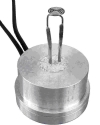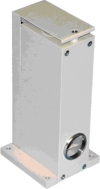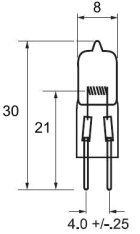INFRARED SOURCES
The infrared sources described below have been designed for both Fourier Transform InfraRed (FTIR) Spectrophotometry and general use. They can easily be interfaced to several types of existing commercial infrared spectrophotometers.
Each IR source is manufactured from a unique high temperature wire alloy developed especially for infra red spectrophotometry and allowing continued use in the range of 1150-1200 °C. This high temperature provides both high radiance and high emissivity not available from other alloys.
Net radiance is equal or even superior to both Ceramic and Nernst designs. The following types of sources are available as standard:
 |
Type 1: IR source – 2.5V The dimensions are 70 mm length x 36mm diameter. The source is internally screened by a unique ceramic sleeve. The diameter of the emitter – 6 mm. |
 |
Type 2: IR source – 5.0V The dimension are 37 mm length x 26 mm diameter. The source is internally screened by a unique ceramic sleeve. The diameter of the emitter – 5 mm. |
 |
Type 3: retrofit coil – 2.5V A standard replacement source (retrofit coil) for Interspec type FTIR spectrometers mounted for IR source type 1. Overall length is 37mm, the diameter of the emitter – 6 mm. |
 |
Type 4: IR parallel source – 2.5V A collimated infra red source employing a type 1 source interfaced to a parabolic off-axis mirror. The output is a collimated infra red beam with the diameter 25 mm. Optical axis of the beam is 35 mm above the floor. |
 |
Type 5: NIR source (QTH lamp) – 6V Light from quartz tungsten halogen lamp (QTH) lamps is emitted by a heated filament. The filament is enclosed in a quartz envelope filled with gases. The spectral distribution is close to that of a blackbody curve with a color temperature of approximately 3000K. QTH lamps have a useful spectral output from visible to to infrared region with several advantages: a smooth spectrum without lines, high output in the visible and in near-infrared regions, high temporal and spatial stability and inexpensive operation. |
